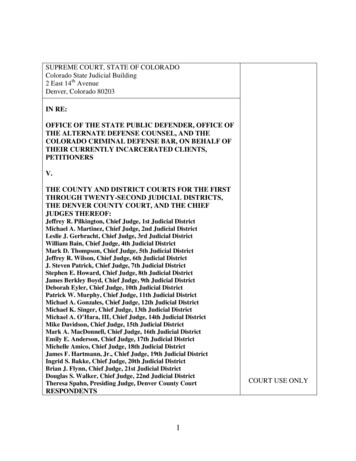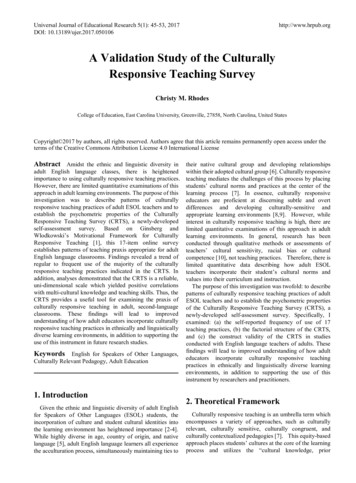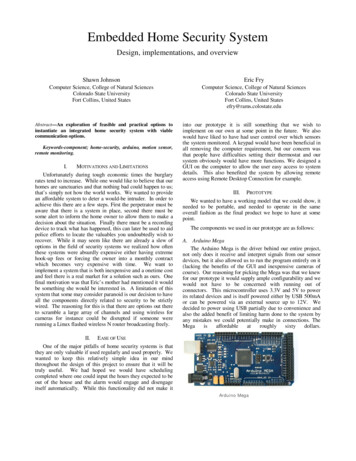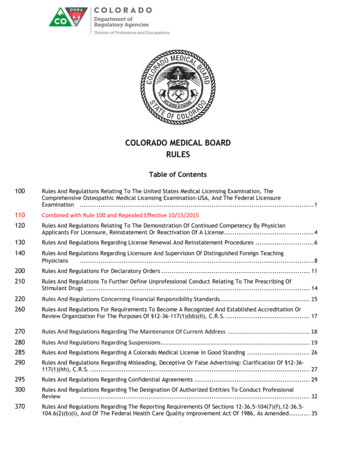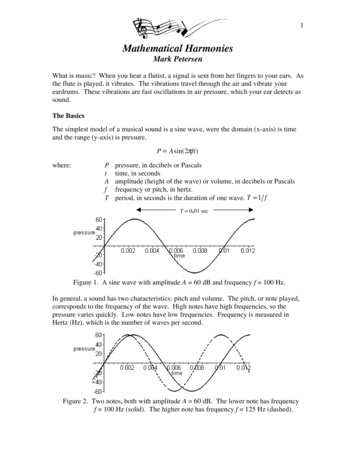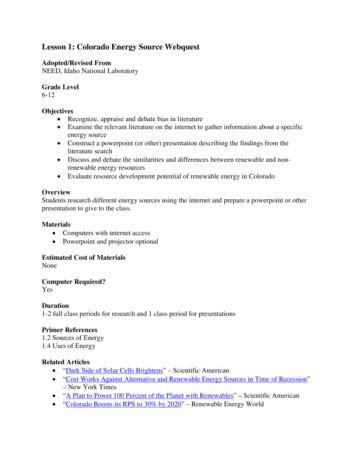
Transcription
U.S. Department of TransportationNational Highway Traffic Safety AdministrationPeople Saving Peoplehttp://www.nhtsa.dot.govA Colorado Validation Studyof theStandardized Field Sobriety Test (SFST) BatteryFinal Report Submitted toColorado Department of TransportationNovember 1995Marcelline Burns, Ph.D.Southern California Research InstituteLos Angeles, CaliforniaEllen W. Anderson, DeputyPitkin County Sheriff’s OfficeAspen, ColoradoThis report was funded by the Office of Transportation Safety, ColoradoDepartment of Transportation(utilizing National Highway Traffic Safety Administration funds under ProjectNumber 95-408-17-05)
Project StaffPitkin County Sheriff’s OfficeRobert C. BraudisSheriffEllen AndersonDeputy SheriffContract DirectorProject CoordinatorSouthern California Research InstituteMarcelline Burns, Ph.D.Theresa BrownDary FiorentinoBarbara MauchInvestigatorData ProcessorTechnical ConsultantSoftware ConsultantThe authors wish to convey special thanks toPaul Helzer and John CongerOffice of Transportation Safety,Colorado Department of Transportation***Second Printing, September 1996
Technical SummaryIn the State of Colorado, motor vehicle operators are subject to arrest if they are found to be drivingwith a blood alcohol concentration (BAC) over 0.05%. At BACs above 0.05% but less than 0.10%, they arecharged with Driving While Ability Impaired (DWAI). At BACs of 0.10% and higher, the charge isDriving Under the Influence (DUI). These statutes reflect the evidence from both epidemiological andlaboratory studies of alcohol impairment of driving skills.It is the responsibility of law enforcement officers to detect and arrest alcohol-influenced drivers inaccordance with these statutory limits. In an effort to meet that objective, police officers, not only inColorado but in all fifty of the United States, rely on a battery of standardized field sobriety tests (SFSTs).Observations of drivers’ performance of the tests, together with driving pattern, appearance and manner,odor of alcohol, and other signs, underlie officers’ arrest and release decisions.To be genuinely useful, roadside tests must be valid and reliable; i.e., they must measure changes inperformance associated with alcohol and they must do it consistently. To the extent that they meet thevalidity and reliability criteria, they can be expected to contribute to traffic safety by increasing thelikelihood that alcohol-impaired drivers will be removed from the roadway by arrest. Importantly, they alsowill further serve the driving public’s interests by decreasing the likelihood that a driver who is not alcoholimpaired will be mistakenly detained or arrested. Thus, the validity and reliability of the tests are importantissues.This study was undertaken specifically to extend study of the SFSTs from the laboratory setting to fielduse. The primary study question was, “How accurate are officers’ arrest and release decisions when theSFSTs are used by trained and experienced officers?” Over a five-month period, officers from sevenColorado law enforcement agencies who volunteered for the study provided the records (N 305) fromevery administration of the SFSTs.Using only the standardized 3-test battery (Walk-and-Turn, One-Leg Stand, Horizontal GazeNystagmus), officers seldom erred when they decided to arrest a driver.Breath or blood specimens confirmed that 93%of the arrested drivers were above 0.05% BAC.Officers were more likely to err on the side of releasing drivers than on the side of incorrectlyarresting drivers. Given the difficulty of the task which confronts officers at roadside, in particular withalcohol-tolerant individuals, the finding that approximately one-third of the released drivers should havebeen arrested is not unexpected. However, it is important to note that officers’ decisions to release werecorrect two-thirds of the time.Overall, 86% of the officers’ decisions to arrestor release drivers who provided blood orbreath specimens were correct.It is concluded that the SFSTs are valid tests; i.e., they serve as indices of the presence of alcohol atimpairing levels. The study design did not support an examination of test-retest reliability. It should benoted, however, that the test battery appears to have served equally well across agencies and officers,strongly suggesting that it achieves acceptable reliability as well.
Table of ContentsI. IntroductionII. Study Background and RationaleIII. Study DesignIV. MethodA. Data IntegrityB. CompletenessC. StandardizationD. TrainingE. Data InstrumentsF. Data SecurityG. Data AnalysisV. ResultsA. OfficersB. ObserversC. Officers’ Decisions1. Correct Decisions and Errors for Subjects with Known BACs2. Changes in the Distribution of Correct Decisions and Errors, Assuming a 0.08% DUI Statute3. Correct Decisions and Errors for Total SampleD. Drivers’ BACsE. Field Sobriety Tests1. Walk and Turn Test (WAT)2. One Leg Stand (OLS)3. Horizontal Gaze Nystagmus (HGN)4. SFSTs and Incorrect Arrests5. SFSTs and Incorrect ReleasesF. Observer RecordsG. Driver CharacteristicsH. Environment and Weather ConditionsVI. Summary and DiscussionReferencesAppendicesI Colorado StatuteII Study DocumentsSummary of Study DocumentsCertifications of Complete RecordsInformed ConsentObserver ChecklistOfficer ChecklistOfficer InformationIII Training ProtocolIV List of Records by Control Number, BAC, and DispositionV Distribution of Records by Month, Day, and OfficerVI Circumstances and Characteristics of 12 Incorrect Arrests
Table of TablesTABLE1 Officer Roster, Ranked by Years of Law Enforcement Experience2 Officer Roster, Ranked by Number of DUI Arrests3 Observer Roster4 Officers’ Arrest and Release Decisions for Drivers with Measured BACs5 Officers’ Arrest and Release Decisions for Total Sample6 Ethnicity of Drivers7 Drivers’ Occupation8 Drivers’ Ages9 Environment/Weather Conditions
Table of FiguresNUMBER1Decision Matrix2Number of Stops/Arrests by Month3Officer Experience4Reported Total Number of DUI Arrests, by Officer5Officers’ Decisions: Subjects with Breath Tests6Arrest/Release Decisions for 234 Drivers with Measured BACs7Arrest/Release Decisions without BACs8Officers’ Decisions: Total Sample9BAC Distribution: DUI Drivers10 BAC Distribution: DWAI Drivers11 BAC Distribution: Incorrect Decisions12 HGN Scores by BAC Groups13 Drivers’ Ages (numbers)14 Drivers’ Ages (percentages)15 Stops and Arrests by Day of Week16 Light Conditions
I. IntroductionA battery of standardized field sobriety tests (SFSTs), which was developed under National HighwayTraffic Safety (NHTSA) funding during the 1970’s, is now used by police officers nationwide. Trafficofficers in fifty states, who have been trained in standardized administration of the tests, routinely use themand incorporate their observations of drivers’ test performance into their arrest or release decisions.Defense attorneys, however, often challenge the admissibility of court testimony about the test battery.Roadside decisions are a critical component of alcohol-and-driving enforcement and, therefore, oftraffic safety. Because the SFSTs aid officers in the often-difficult task of identifying alcohol-impaireddrivers, it is likely that the tests have contributed in some unknown measure to the significant decline inalcohol-related fatalities over the last decade. Given that they have exerted a positive impact on trafficsafety, it is important to resolve questions about their validity and reliability, to maintain their credibility,and to preserve them as a roadside tool.Because court arguments about SFSTs focus largely on the research conducted at the SouthernCalifornia Research Institute (SCRI) and because that research is sometimes misrepresented ormisunderstood, it is necessary first to clarify its purpose. Two large-scale laboratory experiments wereconducted for the purpose of identifying and standardizing a “best” set of tests (Burns and Moskowitz,1977; Tharp, Burns and Moskowitz, 1981). Although it clearly is relevant at this point in time to inquirewhether the methods of those experiments were scientifically sound, it should be recognized that thelaboratory data are now only indirectly enlightening about current roadside use of the tests. In particular,note that controlled laboratory conditions are less variable and, therefore, may be less challenging than thehighly varied conditions which officers routinely encounter in the field.Also, officer experience with the SFSTs is key to the skill and confidence with which they use them asa basis for their decisions. Thus, it is important to understand that the officers who participated in the SCRIstudies had not been trained with the SFSTs until just prior to the experiments. They had not hadopportunity and time to gain skill or to develop confidence in the tests. In contrast, many of the officerswho now use and testify about the tests have been using them regularly for ten or more years, and it isreasonable to assume they have gained skill and to expect that their decisions based on the tests may bemore accurate than those of the officers during the initial research.The question to be addressed in 1995 by agencies, officers and the courts is, “How accurate are thearrest decisions which are made by experienced, skilled officers under roadside conditions when they relyon SFSTs?”. A broadly applicable answer cannot be found in laboratory research. It requires field data; i.e.,information about real-world arrest decisions by officers trained by NHTSA guidelines to administer theSFSTs.The Colorado Department of Transportation funded a 1995 study to obtain such data. Through a grantto the Pitkin County Sheriff’s Office and with the cooperative effort of seven Colorado law enforcementagencies, records were collected from drivers tested with the SFSTs at roadside. The seven agencies were:Aspen Police Department (APD)Basalt Police Department (BPD)Boulder County Sheriff’s Office (BCSO)Colorado State Patrol (CSP)Lakewood Police Department (LPD)Pitkin County Sheriff’s Office (PCSO)Snowmass Village Police Department (SVPD)With information drawn from impaired-driving records, a data base was created and analyzed at theSouthern California Research Institute.
II. Study Background and RationaleWhenever a police officer observes a driving error or equipment violation and takes action bystopping the vehicle, he/she must subsequently make a decision to arrest or release the driver. Thoseforced-choice decisions include driving-under-the-influence (DUI) decisions about drivers who may or maynot have been drinking alcohol and who may or may not be legally under-the-influence. DUI arrestdecisions fall into one cell of the Figure 1 matrix.FIGURE 1DECISION MATRIXAs illustrated by the figure, the decisions may be correct under two different conditions. A “CorrectArrest” (Cell 1) occurs when an officer correctly decides, as confirmed by a chemical test, that the driver’sblood alcohol concentration (BAC) is at or above legally-defined limits for driving. In Colorado’s twotiered system, drivers are charged with driving-under-the-influence if their BACs are 0.10% or higher.They are charged with a lesser offense of driving-while-ability-impaired (DWAI) if their BACs are in therange 0.050 to 0.100%. A copy of the Colorado statute appears in Appendix I.A second kind of correct decision occurs whenever a driver has not been drinking, or has been drinkingonly a very small amount. When the officer correctly concludes that the driver is not DUI or DWAI, asdefined by the BAC limits, he has made a Correct Release decision (Cell 4). Whether that driver actually isor is not impaired at a low BAC is a separate issue, which was not specifically addressed in this study.Decisions may also be incorrect in two different ways, each with different consequences. An “IncorrectArrest” occurs when an officer decides that the driver is DUI or DWAI, but a breath test shows the driver tobe below the criterion level (Cell 3). For this analysis an Incorrect Arrest is defined strictly in terms of theBAC statute and does not speak to the more difficult question of the individual driver’s impairment. Theofficer’s incorrect arrest error, defined by a strict BAC criterion, may in fact not be an error in the sensethat the driver may actually be impaired at a low BAC, may be impaired by a low level of alcoholcombined with some other substance, or may be alcohol free but impaired by some other substance orcombination of substances. Fortunately, true Incorrect Arrests for alcohol are relatively rare. When theyoccur, however, citizens are likely to be angered by having been detained. Certainly, officers wish to avoidthe appearance of undue harassment, as well as to minimize nonproductive contacts with citizens.A second type of error, an “Incorrect Release,” occurs when a driver is at or above the BAC criteria andis stopped but then released. The officer concludes either that the driver has not been drinking or that he/sheis not impaired (Cell 2). Typically, this kind of error occurs more frequently than Incorrect Arrest errors,and it has potentially more serious consequences for traffic safety. There is a risk that the impaired driver,who is allowed to proceed, will be involved in a crash before reaching a destination. A second and lessfrequently recognized and unfortunate consequence of the error is that it may reinforce drinking-drivingbehavior. Some number of persons, who drive after drinking and who are released after being stopped, willconclude that they can continue to drink-and-drive without risk of penalty.Two of these four decision categories, Correct Arrests and Incorrect Arrests, can be confirmed withreasonable speed by breath or blood tests. Unless the arrested drivers refuse to provide specimens fortesting, their BACs can be determined either immediately with breath specimens or within a day or twowith analysis of blood specimens.Data to determine whether and under what conditions the releas-
es of drivers are errors are more difficult to obtain, i.e., data to confirm Correct and Incorrect Releases. Inmost cases, when an officer releases a driver after a roadside examination, no specimen for measuring BACis obtained. Without breath or blood specimens, questions about the accuracy of officers' decisions willremain unanswered. Because data pertaining to released drivers are difficult to obtain, they do not oftenappear in assessments of officer performance.
III. Study DesignThis study was designed to:(1) gather data to assign officers’ decisions to the four cells of the decision matrix illustrated in Figure 1,and to(2) examine the accuracy of the SFST battery when used in the widely varying weather conditions ofColorado winter, spring, and summer months.Both the design and the execution of the study focused on the integrity, completeness, andstandardization of the data.It is important to note how the study population was defined and how the sample of subjects was drawn.Subjects were a subset of the population of drivers who were detained by police officers during the studyperiod. They were drivers, both those arrested and those released, who were stopped by police officersduring the study period and who were requested to perform the SFSTs. The officers’ decisions about thosedrivers have been analyzed in terms of correct decisions (Correct Arrests and Correct Releases) and errors(Incorrect Arrests and Incorrect Releases).In a broader context, the terms Correct Releases and Incorrect Releases could be extended to motoristswho were stopped but who were not asked to perform the SFSTs. In many of those cases, the releasedecisions were correct, but it is likely that some of them were impaired drivers who were released withoutever being asked to perform the SFSTs. Those individuals and those decisions are of interest and would beincluded in an assessment of overall proficiency in DUI detection and arrest. In fact, the entire populationof impaired drivers, only some of whom are detected and stopped, is of interest in terms of traffic safety. Ina validation study of SFSTs, however, the subjects were only those drivers who were asked to perform thetests.
IV. MethodA. Data IntegrityIt was necessary to develop study procedures which insured that decisions to arrest were based solelyon roadside observations and SFSTs. Officers used only the 3-test battery, Walk-and-Turn, One-Leg Stand,and Horizontal Gaze Nystagmus. If it was the policy of the agency or the individual officer to useadditional tests, that practice was set aside for the duration of the study. Also, officers were not equippedwith preliminary breath testers (PBTs) during the study.Data integrity was emphasized during pre-study orientation sessions. To minimize competitivenessbetween officers or agencies, no feedback was given to anyone during data collection. Officers were toldthat their agencies would receive details of their performance, but that the final report would not identifyarrests by officer name.Trained observers, who were present during the contact with 125 (41%) of the subjects, obtained datawhich were critical to study objectives. They monitored the administration of the SFSTs, confirmed that noother roadside tests were given and that the officer did not have a PBT, and obtained BACs from releaseddrivers.The importance of the observers’ role in the study is underscored by the experience with an earlier fieldstudy of SFSTs (T. Anderson, R. Schweitz, and M. Snyder, 1983). When that study is cited in court, it oftenis noted that because some of the officers had access to PBTs, it is not possible to state with certainty thatthey did not know drivers’ BACs prior to making their arrest decisions. BACs obtained with PBTs couldhave inflated their accuracy rate, and the contribution of the SFSTs to their decisions cannot beunequivocally determined.In this study, the observer completed a checklist (Appendix II) each time the SFSTs were administeredand reported the following for each of the three roadside sobriety tests:Were instructions given correctly?Was the test administered correctly?If the test was not given, what was the reason?If the test was not observed, what was the reason?Whenever an officer decided to release a driver, the observer then asked that driver to provide avoluntary breath specimen for PBT measurement of BAC. Since no arrest was being made and noevidential breath specimen would be available, the BACs obtained by the observers were essential in orderto calculate estimates of officers’ accuracy in releasing drivers.When drivers were asked to provide voluntary breath specimens, they were told that if found to be at animpairing alcohol level, transportation would be provided. They were told further that an arrest would bemade only if they attempted to drive away from the scene. Whenever drivers agreed to provide thespecimen, the Informed Consent document (Appendix II) was offered for signature.B. CompletenessBecause it is possible for incomplete data sets to be systematically and significantly biased in knownand unknown ways, the data for this study included the entire work product of the officers who participatedin the study. Work product was defined as the reports for every occasion of administering the SFSTs.Data collection methods, which were designed to meet study requirements without unacceptabledisruption of an agency’s established procedures, insured that all records were available. Reports weretracked by the Computer Aided Dispatch (CAD) numbering system that attaches a unique number to eachreport. The CAD numbers were used to resolve questions about missing data.The participating agencies copied all study documents and forwarded them to the Project Manager, whoverified that they were com-
plete. At the end of the data collection period, all participating officers and observers signed certificationsattesting that the records of all their contacts with drivers, which had involved th
Technical Summary In the State of Colorado, motor vehicle operators are subject to arrest if they are found to be driving with a blood alcohol concentration (BAC) over 0.05%. At BACs above 0.05% but less than 0.10%, they are charged with Driving While Ability Impaired (DWAI).Cited by: 15Page Count: 89File Size: 2MBAuthor:
